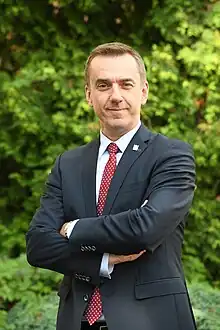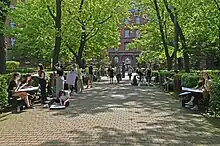Politechnika Krakowska im. Tadeusza Kościuszki | |
 | |
| Type | Public university |
|---|---|
| Established | 1 kwietnia 1945 |
| Rector | Professor Andrzej Szarata |
Academic staff | 1111 |
Administrative staff | 867 |
| Students | 12 201 |
| Address | Warszawska 24, 31-155 Kraków , , |
| Campus | Urban |
| Affiliations | SOCRATES, EUA, EAIE |
| Website | www |
 | |
| University rankings | |
|---|---|
| Regional – Overall | |
| QS Emerging Europe and Central Asia[1] | 73 (2022) |
Cracow University of Technology (Polish: Politechnika Krakowska im. Tadeusza Kościuszki) is a public university located in central Kraków, Poland, established in 1945 and, as an institution of higher learning granted full autonomy in 1954.
The biggest advantages of Cracow University of Technology (CUT) are: almost 80-year-old tradition of educating engineers, modernity and openness to change as well as hard work on the improvement of the Polish scientific and technical thought. Thanks to them CUT won a strong position and well established brand.
Organizational structure
Cracow University of Technology comprises 8 faculties with 30 majors of study accredited by the Polish Accreditation Committee.
- Faculty of Architecture,
- Faculty of Computer Science and Telecommunications
- Faculty of Electrical and Electrical Engineering
- Faculty of Civil Engineering
- Faculty of Materials Engineering and Physics
- Faculty of Environmental Engineering and Energy
- Faculty of Chemical Engineering and Technology
- Faculty of Mechanical Engineering
Also the majors taught by the Faculty of Civil Engineering and the Faculty of Architecture are accredited by the European Network for Accreditation of Engineering Education. Moreover the major in Architecture is accredited by the Royal Institute of British Architects (RIBA) and the major in Landscape Architecture earned the accreditation of the International Federation of Landscape Architects (IFLA) Europe. Cracow University of Technology was awarded the Logo Human Resources Excellence in Research by the European Commission.
Currently nearly 14,000 students taking full-time, part-time and Ph.D. studies as well as post-graduate studies with nearly 1,100 academic teachers overseeing their education. Total number of alumni that graduated from PK exceed 80 000. Our alumni find jobs at public and private companies, national and international enterprises, government administration, and also at universities and research institutes. We are committed to ensure that all the PK graduates represent a high level of expertise as well as the highest ethical standards so that they can choose from many interesting job offers.
Cooperation with many universities and scientific centres all over the world enables joint publications and research, exchange of students and academic teachers, as well as the possibility of obtaining additional certificates and double diplomas. Cooperation with industry is also well-developed, and a Technology Transfer Centre is active in the university. A Special Economic Zone - the Cracow Technological Park - was created in 1997 as a reply for a call from the university. It has since become a platform linking the Cracovian scientific world with modern technologies.
Authorities

Rector
- prof. dr hab. inż. Andrzej Szarata
Vice-rectors
- prof. dr hab. inż. Dariusz Bogdał
- dr inż. Marek Bauer
- dr hab. inż. arch. Tomasz Kapecki, prof. PK
- dr hab. inż. Jerzy Zając, prof. PK
Rectors
- Izydor Stella-Sawicki (1945–1948)
- Ludomir Sleńdziński (1954–1956)
- Bronisław Kopyciński (1956–1965)
- Kazimierz Sokalski (1965–1968)
- Jan Kaczmarek (1968)
- Jan Wątorski (1968–1972)
- Władysław Muszyński (1972–1975)
- Bolesław Kordas (1975–1981)
- Roman Ciesielski (1981–1982)
- Tadeusz Środulski (1982–1987)
- Władysław Muszyński (1987–1990)
- Józef Nizioł (1990–1996)
- Kazimierz Flaga (1996–2002)
- Marcin Chrzanowski (2002–2005)
- Józef Gawlik (2005–2008)
- Kazimierz Furtak (2008–2016)
- Jan Kazior (2016–2020)
- Andrzej Białkiewicz (2020-2023)
- Andrzej Szarata (2023-)
Localization

The University main campus in Warszawska street is located in the 19th c. barracks constructed under the supervision of Antoni Łuszczkiewicz. The building complex, the largest of its kind in Cracow, was named after the Archduke Rudolf, successor to the Austrian throne. Until 1912 the Austria-Hungary army was stationed here; in the interwar period the barracks were given the name after King Jan III Sobieski and the Polish army was based in the buildings.
After World War II the complex in Warszawska Street was presented to the Cracow University of Technology. The building which was formerly occupied by the army headquarters is now the seat of the University authorities and the Faculty of Civil Engineering. The other historic buildings house the Faculties of Electrical and Computer Engineering, Environmental Engineering and Energy and Faculty of Architecture, the university library and museum. The historic facades of the buildings have been renovated recently, so the seat of the Cracow University of Technology is a perfect example of combining history and the present.

The Faculty of Architecture and the Faculty of Materials Engineering and Physics are located in the former Royal Palace in Łobzów. The palace was the oldest royal summer residence. It is there that King Ladislaus IV was born. The residence, destroyed during the Swedish invasion, was rebuilt by King Jan III Sobieski. A legend has it that it is here, not the Wawel Castle, that King Jan chose to celebrate the victory in the war with Turkey. The palace in Łobzów became the property of the Cracow University of Technology after World War II, and in 1983 was included in the list of historic monuments.
One of the institutes of the Faculty of Architecture and Zależny Theatre are housed in the Palace of Samuel Maciejowski in Kanonicza Street. This 16th c. building is a magnificent example of a combination of various architectural styles – from the Renaissance through the Baroque to the 19th c. classicist superstructure with Neo-Renaissance facade. Some original elements of the building have been preserved, for example the arcaded loggia in the courtyard and the limestone portal leading to the cellar
International cooperation
The Cracow University of Technology is a member of the European University Association, and in 2023, together with eight other universities, formed a European University called Stars EU (Strategic Alliance for Regional Transition) and cooperates with scientific centres around the world, not only in the field of science and research but also in the exchange of students and research and teaching staff.
Within the framework of the „Erasmus+” programme, exchanges are carried out with most European countries. Outside this programme, bilateral agreements allow for cooperation with universities from over 50 countries, including the United States, Japan, Australia, the Republic of Korea, China, India, Mexico, Chile, Colombia, Ukraine, Brazil and Singapore. The University has also signed dual degree agreements, such as with Cranfield University in the UK, Fachhochschule Münster and Technische Universität Bergakademie Freiberg in Germany, University of Cagliari in Italy and Lviv Polytechnic National University in Ukraine. In addition, some of the courses taught at the University are accredited by prestigious foreign institutions: architecture - Royal Institute of
- British Architects (RIBA);
- landscape architecture – International Federation of Landscape Architects (IFLA) Europe
- architecture, construction, transportation – European Network for Accreditation of Engineering Education (ENAEE)
- The University also cooperates with foreign scientific and research institutions, including the European Organization for Nuclear Research (CERN)
The agreement signed with the institution in 2015 was preceded by 25 years of cooperation. Researchers at the University contributed to the creation and improvement of the Large Hadron Collider and the introduction of reliability function-based analysis into the design of elementary particle accelerators. Under the agreement, employees, students and graduates of the University participate in the work of CERN research teams.
Rankings
The final results of the evaluation of scientific disciplines i.e. assessment of the quality of scientific activity at Polish universities and research institutes have been announced. The evaluation was carried out by an independent body of experts. Cracow University of Technology (CUT) was awarded with the highest (in the rating scale) scientific categories A+ and A.
8 scientific disciplines were assessed at Cracow University of Technology. Architecture and Urban Planning discipline received scientific category A+. 7 other disciplines such as: Information Technology and Telecommunications, Automation, Electronics and Electrical Engineering, Chemical Engineering, Civil Engineering and Transport, Materials Engineering, Mechanical Engineering, Environmental Engineering, Mining and Energy, received category A. The high scientific categories achieved by Cracow University of Technology placed our university among the three top Polish universities.
Evaluation, i.e. evaluation of the achievements and achievements of researchers at universities and research institutes, takes place every few years. In the recently completed evaluation for the years 2017-2021, an independent expert body assessed the quality of scientific activity within the disciplines of science, practiced by a given entity. On this basis, the Minister of Education and Science awarded the following categories to scientific disciplines at universities: A+, A, B+, B or C. The assessment took into account scientific publications in prestigious journals and publishing houses, patents obtained, ongoing scientific projects, as well as financial effects of research and its impact on society and economy.
Notable alumni
See also
References
- ↑ "QS World University Rankings-Emerging Europe & Central Asia". Retrieved 15 January 2023.
External links
- Cracow University of Technology, home page (in English)
- Politechnika Krakowska, home page (in Polish)